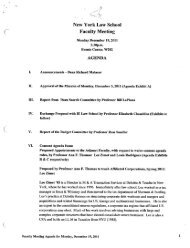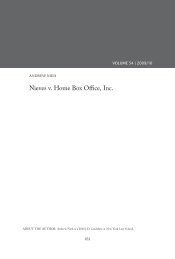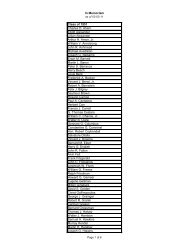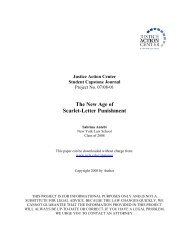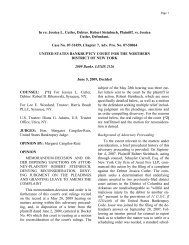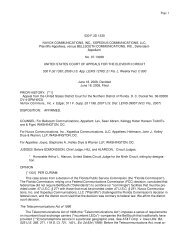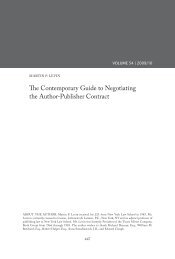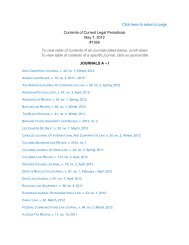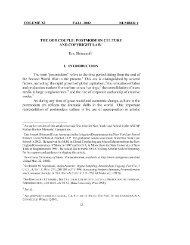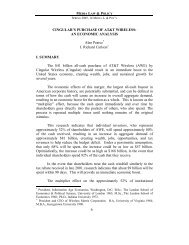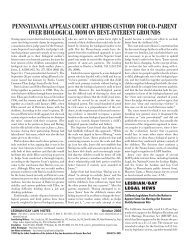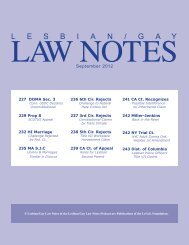From Hero to Villain - New York Law School
From Hero to Villain - New York Law School
From Hero to Villain - New York Law School
Create successful ePaper yourself
Turn your PDF publications into a flip-book with our unique Google optimized e-Paper software.
AMY S. BEARD<br />
voLUMe 55 | 2010/11<br />
<strong>From</strong> <strong>Hero</strong> <strong>to</strong> <strong>Villain</strong>: The Corresponding<br />
Evolutions of Model Ethical Codes and the<br />
Portrayal of <strong>Law</strong>yers in Film<br />
ABOUT THE AUTHOR: Amy S. Beard, Esq., is an associate in the Litigation and Dispute Resolution<br />
Department of Tannenbaum Helpern Syracuse & Hirschtritt LLP. Ms. Beard is the co-author of several<br />
publications on diversity in the legal profession, including the book Attracting, Advancing and Retaining<br />
LGBT <strong>Law</strong>yers, published in 2009. She also presented a paper, Approaches <strong>to</strong> Sexual Orientation Harassment<br />
Claims under Title IX, at the Oc<strong>to</strong>ber 2009 symposium hosted by Bos<strong>to</strong>n University’s Public Interest <strong>Law</strong><br />
Journal. Ms. Beard is a 2007 graduate of <strong>New</strong> <strong>York</strong> University <strong>School</strong> of <strong>Law</strong>.<br />
961
FroM hero To viLLaiN<br />
i. intrOdUCtiOn<br />
It should come as no surprise that lawyers and courtrooms are frequent <strong>to</strong>pics on<br />
the silver screen. The adversarial nature of trials is inherently dramatic, and that<br />
nature—pitting one side against another in an effort <strong>to</strong> expose or obfuscate the<br />
truth—means that trials are equally suited <strong>to</strong> both “morality plays,” in which the<br />
righteous prevail and the guilty are punished, and more complex dramas, in which<br />
the nature of truth itself is under as much scrutiny as the evidence before the court.<br />
<strong>Law</strong>yers, <strong>to</strong>o, are easy targets for the screenwriter’s and direc<strong>to</strong>r’s commentary due <strong>to</strong><br />
the multifaceted roles they can play in the legal system: devoted advocate (for good or<br />
ill), passionate activist, and reluctant hero.<br />
The portrayal of lawyers in film has changed over time, a transition that has not<br />
gone unnoticed by scholars. 1 <strong>Law</strong>yers in Hollywood movies (“movie-lawyers”) made<br />
in the 1950s and 1960s were almost universally just and moral men, 2 even when they<br />
were on the losing end of their courtroom battle. 3 In movies made in the 1990s, the<br />
lawyer-hero was a much rarer character, and lawyers were much more often depicted<br />
as either comic buffoons 4 or incompetent or corrupt hired guns selling their services<br />
<strong>to</strong> the highest bidder, regardless of ethical concerns. 5<br />
There are undoubtedly a number of causes for this evolution, and pinpointing the<br />
particular reasons is beyond the scope of this article. However, an interesting<br />
correlation appears when samples of movies from the middle and end of the twentieth<br />
century are examined in conjunction with the model code of ethics endorsed by the<br />
American Bar Association (ABA) in effect at the time those movies were made.<br />
Specifically, as lawyers in film became less admirable, the ABA’s model codes of<br />
ethics were likewise becoming less aspirational. For scholars interested in examining<br />
the portrayal of lawyers in film or the evolution of legal ethics, this correlation<br />
presents an interesting, new area of study.<br />
This article is intended <strong>to</strong> begin an exploration of this correlation. In Part II,<br />
selected movies from the 1950s and 1960s are compared with the Canons of Legal<br />
Ethics. In Part III, selected movies from the 1990s are compared with the Model<br />
Rules of Professional Responsibility. The movies were selected based on the emphasis<br />
1. See, e.g., Paul Bergman & Michael Asimow, Reel Justice: The Courtroom Goes <strong>to</strong> the Movies<br />
(2d ed. 2006); Michael Asimow, <strong>Law</strong>yers and Popular Culture: Bad <strong>Law</strong>yers in the Movies, 24 Nova L.<br />
Rev. 533 (2000); Carrie Menkel-Meadow, Can They Do That? Legal Ethics in Popular Culture: Of<br />
Characters and Acts, 48 U.C.L.A. L. Rev. 1305 (2001).<br />
2. The gender-specific noun is appropriate here, as most, if not all, lawyers in movies of the 1950s and<br />
1960s were male.<br />
3. See, e.g., Cape Fear (Melville-Talbot Productions 1962); Compulsion (20th Century Fox 1959);<br />
Judgment at Nuremberg (Roxlom Films Inc. 1961); To Kill a Mockingbird (Universal Pictures<br />
1962).<br />
4. See, e.g., Liar Liar (Universal Pictures 1997); My Cousin Vinny (20th Century Fox 1992).<br />
5. See, e.g., Cape Fear, supra note 3; Sleepers (Warner Bros. Pictures 1996); The Devil’s Advocate<br />
(Warner Bros. Pictures 1997).<br />
962
nEW yOrK LaW sChOOL LaW rEViEW VOLUME 55 | 2010/11<br />
of the law and at<strong>to</strong>rneys in the plot, box office performance, and critical acclaim. 6<br />
While the sample size of movies surveyed in this article is limited, the correlation<br />
between the respectability of the lawyers portrayed in films and the aspirational<br />
nature of model ethical code in effect at the time is nonetheless clear. 7<br />
II. ThE 1950s and 1960s: thE CanOns Of LEgaL EthiCs and thE hErOiC<br />
MOViE-LaWyEr<br />
The ABA established its first code of conduct, called the Canons of Legal Ethics<br />
(the “Canons”), in 1908. With only a few amendments, the Canons remained in<br />
place until 1969. 8 Prior <strong>to</strong> the passage of the Canons, some commenta<strong>to</strong>rs suggested<br />
that the administration of justice was <strong>to</strong>o contentious. In 1905, for example, President<br />
Theodore Roosevelt called lawyers “hired cunning” and disparaged them for<br />
thwarting the public interest in favor of lucrative representations of the wealthy. 9 At<br />
an ABA convention the next year, then-dean of University of Nebraska College of<br />
<strong>Law</strong>, Roscoe Pound, advocating for reform, said:<br />
The idea that procedure must of necessity be wholly contentious disfigures<br />
our judicial administration at every point. . . . It leads counsel <strong>to</strong> forget that<br />
they are officers of the court and <strong>to</strong> deal with the rules of law and procedure<br />
exactly as the professional football coach deals with the rules of the sport. It<br />
leads <strong>to</strong> exertion <strong>to</strong> “get error in<strong>to</strong> the record” rather than <strong>to</strong> dispose of the<br />
controversy finally and upon its merits. It turns witnesses, and especially<br />
expert witnesses, in<strong>to</strong> partisans pure and simple. It leads <strong>to</strong> sensational crossexamination<br />
“<strong>to</strong> affect credit,” which have made the witness stand “the<br />
slaughterhouse of reputations.” It prevents the trial court from restraining the<br />
bullying of witnesses and creates a general dislike, if not fear, of the witness<br />
function which impairs the administration of justice . . . . The effect of our<br />
exaggerated contentious procedure is not only <strong>to</strong> irritate parties, witnesses<br />
and jurors in particular cases, but <strong>to</strong> give the whole community a false notion<br />
of the purpose and end of law. 10<br />
6. Box office information was received from Variety.com, www.variety.com (last visited Mar. 23, 2011)<br />
and World Box Off., www.worldboxoffice.com (last visited Mar. 23, 2011) on Oc<strong>to</strong>ber 7, 2002.<br />
However, according <strong>to</strong> variety.com, domestic box office <strong>to</strong>tals are not complete prior <strong>to</strong> 1994. Therefore,<br />
this study only considered box office information for the films of the 1990s. Critical acclaim was<br />
measured by the number of Academy Award nominations and wins a film had; this information was<br />
received from Paul Bergman & Michael Asimow, Reel Justice: The Courtroom Goes <strong>to</strong> the<br />
Movies (2d ed. 2006) and from Academy Awards, The Oscars, Introduction, FilmSite.org, http://www.<br />
filmsite.org/oscars.html#his<strong>to</strong>ry (last visited Mar. 23, 2011).<br />
7. Please note that, although lawyers in movies of the earlier period were not universally admirable, neither<br />
were lawyers in movies of the later period universally deplorable.<br />
8. Model Rules of Prof’l Conduct preface, at ix–x (2009).<br />
9. See James M. Altman, Considering the A.B.A.’s 1908 Canons of Ethics, 71 Fordham L. Rev. 2395, 2399<br />
(2003).<br />
10. Roscoe Pound, The Causes of Popular Dissatisfaction with the Administration of Justice, 29 A.B.A. Rep.<br />
395 (1906), quoted in John M. Barkett, <strong>From</strong> Canons <strong>to</strong> Cannon, in A Century of Legal Ethics:<br />
963
FroM hero To viLLaiN<br />
The preamble of the Canons states that “[t]he future of the Republic, <strong>to</strong> a great<br />
extent, depends upon our maintenance of Justice pure and unsullied. . . . It cannot be<br />
so maintained unless the conduct and the motives of the members of our profession<br />
are such as <strong>to</strong> merit the approval of all just men.” 11 The preamble’s lofty language<br />
suggests that at least one purpose of the Canons was <strong>to</strong> combat the “disfiguring” of<br />
the judicial process <strong>to</strong> which Pound had referred. 12<br />
<strong>From</strong> the preamble <strong>to</strong> the final canon, the Canons emphasize integrity and honor.<br />
Instead of imposing specific requirements on lawyers, the Canons are infused with<br />
aspirational language of respect, 13 fairness, 14 restraint, 15 and above all, duty. 16 They<br />
warn lawyers against “unprofessional,” “dishonorable,” or “disreputable” conduct 17<br />
and counsel lawyers <strong>to</strong> aspire <strong>to</strong> uphold the honor of the legal profession and act<br />
according <strong>to</strong> conscience rather than blindly follow a client’s wishes. 18 Even where<br />
lawyers were advised <strong>to</strong> avoid particular conduct, the Canons recommended rather<br />
than proscribed. 19 The Canons were thus a kind of honor code rather than a rigid set<br />
of rules, charging each lawyer <strong>to</strong> “find his highest honor in a deserved reputation for<br />
fidelity <strong>to</strong> private trust and <strong>to</strong> public duty, as an honest man and as a patriotic and<br />
loyal citizen.” 20<br />
So many lawyers in the movies of the 1950s and 1960s embodied the Canons’<br />
aspirations so perfectly that it is easy <strong>to</strong> imagine that moviemakers had those ideals<br />
in mind when creating these characters. There is no evidence filmmakers were<br />
influenced by the Canons, however, and it is much more likely that the lawyer-hero<br />
ideal of films produced in this period was due, at least in part, <strong>to</strong> Hollywood’s<br />
Production Code of 1930, sometimes referred <strong>to</strong> as the Hays Code. 21 In addition <strong>to</strong><br />
containing numerous rules governing the portrayal of sex, nudity, and the use of<br />
liquor or harsh language, the Production Code required filmmakers <strong>to</strong> portray courts<br />
and law enforcement as just and <strong>to</strong> refrain from showing sympathy for crime or<br />
Trial <strong>Law</strong>yers and the ABA Canons of Professional Ethics 161, 164–65 (<strong>Law</strong>rence J. Fox et<br />
al. eds., 2009).<br />
11. Canons of Prof’l. Ethics pmbl. (1908).<br />
12. Supra note 10.<br />
13. See, e.g., Canons of Prof’l. Ethics Canons 3, 17, 18 (1908).<br />
14. See, e.g., id. Canons 18, 22.<br />
15. See, e.g., id. Canons 15, 16, 23.<br />
16. See, e.g., id. Canons 1–2, 5–6, 8–9, 11, 21, 28, 30, 32.<br />
17. See, e.g., id. Canons 22–23, 25–28.<br />
18. See, e.g., id. Canons 15–16, 29, 31–32.<br />
19. Compare, e.g., id. Canon 10 (stating that a lawyer “should not” acquire an interest in the subject matter<br />
of a litigation), with Model Rules of Prof’l Conduct R. 1.8(a) (2009) (“A lawyer shall not enter in<strong>to</strong><br />
a business transaction with a client or knowingly acquire an ownership . . . interest adverse <strong>to</strong> a<br />
client . . . .” (emphasis added)).<br />
20. Canons of Prof’l Ethics Canon 32 (1908).<br />
21. Bergman & Asimow, supra note 1, at 69–71.<br />
964
nEW yOrK LaW sChOOL LaW rEViEW VOLUME 55 | 2010/11<br />
ridiculing the law. 22 These provisions of the Production Code may have influenced<br />
the portrayal of lawyers in film by encouraging filmmakers <strong>to</strong> portray professionally<br />
admirable and morally upright lawyers or, if the filmmakers’ projects featured bad<br />
lawyers, also showing appropriate punishment. 23<br />
The Production Code had its roots in a 1915 U.S. Supreme Court decision<br />
holding that motion pictures were not an art form and thus not entitled <strong>to</strong> the free<br />
speech protections that other media, such as books, enjoyed. 24 As a result, executives<br />
in the movie industry, seeking <strong>to</strong> derail state and federal attempts <strong>to</strong> regulate or<br />
censor films, formed a trade association 25 and implemented the Production Code,<br />
which required all films shown in U.S. theaters <strong>to</strong> have the trade association’s<br />
certificate of approval. 26 Although compliance with the Production Code was<br />
supposedly voluntary, it was strictly enforced for many years, meaning that no film<br />
could be shown in the United States without trade association approval. 27 Enforcement<br />
began <strong>to</strong> wane in the 1950s after the Supreme Court held that movies were, in fact,<br />
entitled <strong>to</strong> free speech protections, 28 and filmmakers and theaters became more<br />
willing <strong>to</strong> make and exhibit films without trade association approval. 29 Despite the<br />
reduction in enforcement, the Production Code still influenced films up until 1968,<br />
when it was replaced by the ratings system that is still in use <strong>to</strong>day. 30 However, even<br />
if filmmakers were not aware of, or influenced by, the Canons, a survey of films from<br />
the period suggests that, whether moviemakers were aware of the Canons or not,<br />
their movies’ lawyers tended <strong>to</strong> abide by the Canons’ ethical guidelines.<br />
Atticus Finch of 1962’s To Kill a Mockingbird 31 is so nearly the archetype of the<br />
just and honest lawyer that he could have been emblazoned on the Canons’ cover.<br />
Finch, a liked and respected small-<strong>to</strong>wn lawyer in 1930s Alabama, was defense<br />
counsel <strong>to</strong> a black man, Tom Robinson, who was accused of raping Mayella Ewell, a<br />
white woman. 32 Finch’s energetic defense of Robinson calls <strong>to</strong> mind Canon 4, which<br />
reminds lawyers who serve as counsel for the indigent <strong>to</strong> “always exert [their] best<br />
22. Matt Bynum, The Motion Picture Production Code of 1930 (Hays Code), ArtsReformation.com (Apr.<br />
12, 2006), http://www.artsreformation.com/a001/hays-code.html.<br />
23. Bergman & Asimow, supra note 1, at 570–71.<br />
24. Mut. Film Corp. v. Indus. Comm. of Ohio, 236 U.S. 230 (1915), overruled by Joseph Burstyn, Inc. v.<br />
Wilson, 343 U.S. 495 (1952).<br />
25. Then known as Motion Pictures Producers and Distribu<strong>to</strong>rs Association; now called the Motion Picture<br />
Association of America.<br />
26. See Bergman & Asimow, supra note 1, at 69; Bob Mondello, Remembering Hollywood’s Hays Code, 40 Years<br />
On, Nat’l Pub. Radio (Aug. 8, 2008), http://www.npr.org/templates/s<strong>to</strong>ry/s<strong>to</strong>ry.php?s<strong>to</strong>ryId=93301189.<br />
27. Mondello, supra note 26.<br />
28. Joseph Burstyn, 343 U.S. 495.<br />
29. Mondello, supra note 26.<br />
30. See Bergman & Asimow, supra note 1, at 70.<br />
31. To Kill a Mockingbird, supra note 3.<br />
32. Id.<br />
965
FroM hero To viLLaiN<br />
efforts in [the client’s] behalf.” 33 Finch may have saved his best work on behalf of his<br />
client for the courtroom, but he also invested his personal time in (and risked his<br />
own safety for) his client as well, something best demonstrated by his willingness <strong>to</strong><br />
stand guard outside the <strong>to</strong>wn jail in order <strong>to</strong> protect Robinson from a lynch mob. 34<br />
Finch, however, never <strong>to</strong>ok his defense of Robinson <strong>to</strong>o far. His cross-examination<br />
of the prosecution’s witnesses was polite, in accordance with Canon 18, which<br />
recommended that lawyers “always treat adverse witnesses and sui<strong>to</strong>rs with fairness<br />
and due consideration.” 35 Finch also did not allow his zealous representation of<br />
Robinson <strong>to</strong> color his interactions with the prosecution, as he continually treated<br />
opposing counsel with courtesy. 36 As Canon 17 advised, Finch did not let any feelings<br />
he may have had <strong>to</strong>ward opposing counsel influence his conduct or demeanor. 37<br />
While criminal defense was not Finch’s usual work, he brought <strong>to</strong> his defense the<br />
“warm zeal” that Canon 15 admonished lawyers <strong>to</strong> use in the maintenance and<br />
defense of the client’s rights. 38 His closing statement was a moment of soaring ora<strong>to</strong>ry,<br />
pleading for justice on Robinson’s behalf.<br />
Now, gentlemen, in this country, our courts are the great levelers . . . . In our<br />
courts, all men are created equal. I’m no idealist <strong>to</strong> believe firmly in the<br />
integrity of our courts and of our jury system—that’s no ideal <strong>to</strong> me. That is<br />
a living, working reality! Now I am confident that you gentlemen will review,<br />
without passion, the evidence that you have heard, come <strong>to</strong> a decision and<br />
res<strong>to</strong>re this man <strong>to</strong> his family. In the name of God, do your duty. In the name<br />
of God, believe Tom Robinson. 39<br />
While Finch undoubtedly brought the “warm zeal” <strong>to</strong> his fight for Robinson that<br />
the Canons recommended, 40 his battle was not for Robinson alone, but for the<br />
principles of equality and justice, the ability <strong>to</strong> hold his head up before his family and<br />
his <strong>to</strong>wn—in short, it was a battle for the “honor of his profession” and his own<br />
“reputation for fidelity . . . as an honest man,” just as the Canons envisioned. 41<br />
It must be noted, however, that Finch does commit at least one serious ethical<br />
violation, albeit one that goes relatively unnoticed in scholarly commentary on the<br />
case. Under Canon 32, no lawyer should render “any service or advice involving<br />
disloyalty <strong>to</strong> the law whose ministers we are.” 42 Yet Finch does exactly that when he<br />
agrees <strong>to</strong> cover up the identity of Bob Ewell’s killer in order <strong>to</strong> protect a local recluse<br />
33. Canons of Prof’l Ethics Canon 4 (1908).<br />
34. To Kill a Mockingbird, supra note 3, at 1:02:00.<br />
35. Canons of Prof’l Ethics Canon 18 (1908).<br />
36. To Kill a Mockingbird, supra note 3.<br />
37. Canons of Prof’l Ethics Canon 17 (1908); To Kill a Mockingbird, supra note 3.<br />
38. Canons of Prof’l Ethics Canon 15 (1908).<br />
39. To Kill a Mockingbird, supra note 3, at 1:37:07.<br />
40. Canons of Prof’l Ethics Canon 15 (1908).<br />
41. Id. Canon 32.<br />
42. Id.<br />
966
nEW yOrK LaW sChOOL LaW rEViEW VOLUME 55 | 2010/11<br />
from unwanted publicity as a hero. 43 Articles referencing Finch are much more likely<br />
<strong>to</strong> describe Finch as a “good, virtuous lawyer,” 44 “highly ethical, devoted, and<br />
talented,” 45 or “heroic,” 46 rather than <strong>to</strong> mention this transgression. Even when the<br />
cover-up is mentioned, scholars are quick <strong>to</strong> leap <strong>to</strong> Finch’s defense. 47 Perhaps because<br />
the cover-up was done <strong>to</strong> protect a helpless hermit, or perhaps because he otherwise<br />
so perfectly embodies the ideal of an ethical lawyer, it seems Finch can do no wrong<br />
in the eyes of most of his true-life colleagues.<br />
While Atticus Finch might be among the more popular movie-lawyers of the<br />
1960s, 48 he was not the only lawyer hero fighting for “[j]ustice, pure and unsullied”<br />
on the silver screen. 49 Defense at<strong>to</strong>rney Jonathan Wilk in 1959’s Compulsion is another<br />
such character. 50 Wilk, hired by the families of two young law students who were<br />
accused of murder, was not liked by anyone: not his clients, who believed him <strong>to</strong> be<br />
intellectually inferior <strong>to</strong> them; not their families (who were paying for the boys’<br />
defense), who refer <strong>to</strong> Wilk as “that atheist,” “a skeptic who makes a mockery of<br />
religion,” a charlatan, and a lying drunk; and not the <strong>to</strong>wnspeople, who dress up in<br />
Ku Klux Klan uniforms and burn a cross outside his residence. 51 If the <strong>to</strong>wnspeople<br />
sought <strong>to</strong> terrorize Wilk, however, they failed, as his only response <strong>to</strong> the burning<br />
cross was <strong>to</strong> comment dryly that “it’s much <strong>to</strong>o warm for an open fire” and that he<br />
was not worried about people whose response <strong>to</strong> an emotional situation “is <strong>to</strong> pull a<br />
sheet over their heads.” 52<br />
At least in his clients’ families’ view, Wilk may not be the man of “highest honor”<br />
as described in Canon 32, though they do seem <strong>to</strong> find him <strong>to</strong> be the lawyer described<br />
in the Canons’ preamble, a lawyer with motives “such as <strong>to</strong> merit the approval of all<br />
just men.” 53 He is, as the father of one of the defendants put it, “the best trial lawyer<br />
in the country, . . . and he’s fought capital punishment all his life.” 54 Wilk was as<br />
43. To Kill a Mockingbird, supra note 3, at 2:06:00.<br />
44. Lea B. Vaughn, A Few Inconvenient Truths About Michael Crich<strong>to</strong>n’s State of Fear: <strong>Law</strong>yers, Causes and<br />
Science, 20 Se<strong>to</strong>n Hall J. Sports & Ent. L. 49, 69 n.107 (2010).<br />
45. Michael Moffitt, Three Things <strong>to</strong> Be Against (“Settlement” Not Included), 78 Fordham L. Rev. 1203,<br />
1236 (2009).<br />
46. See, e.g., Harper Estes, Texas Legal Legends: My <strong>Hero</strong>es Have Always Been <strong>Law</strong>yers, 72 Tex. B.J. 556, 556<br />
(2009).<br />
47. See, e.g., Bill Hal<strong>to</strong>m, But Seriously Folks: The Trial of Atticus Finch, 45 Tenn. B.J. 34, 35 (2009); Orit<br />
Kamir, Michael Clay<strong>to</strong>n, Hollywood’s Contemporary <strong>Hero</strong>-<strong>Law</strong>yer: Beyond Outsider Within and Insider<br />
Without, 42 Suffolk U. L. Rev. 829, 837 (2009).<br />
48. A Westlaw search for “Atticus Finch” in all law reviews and journals, run May 11, 2010, returned 704<br />
articles; a search with the same parameters for “To Kill a Mockingbird” returned 782.<br />
49. Canons of Prof’l Ethics pmbl. (1908).<br />
50. Compulsion, supra note 3.<br />
51. Id. at 1:05:22, 1:14:22.<br />
52. Id. at 1:14:56.<br />
53. Id. at 1:05:22; Canons of Ethics pmbl., Canon 32 (1908).<br />
54. Compulsion, supra note 3, at 1:05:26.<br />
967
FroM hero To viLLaiN<br />
unconcerned about his clients’ actual guilt or innocence as he was about their personal<br />
disdain for him; perhaps even more than Finch, Wilk’s concern was for justice. 55<br />
Believing that his clients had no chance at being found not guilty, he entered guilty<br />
pleas on their behalf <strong>to</strong> move the proceeding straight <strong>to</strong> sentencing (which would be<br />
handled solely by the judge, rather than a jury) and attempted <strong>to</strong> save his clients from<br />
the gallows. 56 In his powerful closing statement <strong>to</strong> the judge, Wilk demands:<br />
Isn’t a lifetime behind prison bars enough for this mad act? Must this great<br />
public be regaled with a hanging? For the last three weeks I’ve heard nothing<br />
but the cry of blood in this room . . . . Your Honor, if you hang these boys,<br />
you turn back <strong>to</strong> the past. I’m pleading for the future . . . . when we can learn<br />
that all life is worth saving, and that mercy is the highest attribute of man.<br />
Yes, I’m pleading for the future. In this court of law, I’m pleading for love. 57<br />
Wilk <strong>to</strong>ok <strong>to</strong> heart Canon 5’s principle that lawyers have the right <strong>to</strong> defend the<br />
accused and use all fair and honorable means <strong>to</strong> present all legal defenses, regardless<br />
of the lawyer’s opinion on their guilt or innocence. 58 Additionally, like Finch, Wilk<br />
also personified Canon 15’s standard that lawyers owe their “entire devotion <strong>to</strong> the<br />
interest of the client, warm zeal in the maintenance and defense of his rights and the<br />
exertion of his utmost learning and ability.” 59<br />
Ethically speaking, Wilk was not perfect. Under Canon 8, Wilk was “bound <strong>to</strong><br />
give a candid opinion on the merits and probable results” <strong>to</strong> his clients about the<br />
trial, and he was permitted <strong>to</strong> advise his clients <strong>to</strong> avoid the trial by pleading guilty. 60<br />
However, the decision whether or not <strong>to</strong> do so was his clients’ decision, not his. 61<br />
Wilk ignored this ethical principle and made the decision on his own, substituting<br />
his own judgment for that of his clients. He also spoke <strong>to</strong> the press about the case, in<br />
violation of Canon 20—although this violation was, if not excusable, at least<br />
understandable, as Wilk arrived in <strong>to</strong>wn <strong>to</strong> take the case only <strong>to</strong> discover the<br />
prosecu<strong>to</strong>r giving a press conference about it. Wilk was a flawed character, much<br />
more so than Finch, but the net result is, like Finch, a movie-lawyer embodying<br />
Canon 32 and its provisions that a lawyer “advances the honor of his profession”<br />
when he undertakes “exact compliance with the strictest principles of moral law.” 62<br />
No doubt Wilk, with his career-long fight against the death penalty on moral<br />
grounds, would agree he acted out of devotion <strong>to</strong> public duty.<br />
55. Id. at 1:05:26.<br />
56. Id.<br />
57. Id.<br />
58. Canons of Prof’l Ethics Canon 5 (1908).<br />
59. Id. Canon 15.<br />
60. Id. Canon 8.<br />
61. See id. (stating that, whenever the controversy will admit of fair adjustment, the client should be advised<br />
<strong>to</strong> avoid or <strong>to</strong> end the litigation).<br />
62. Id. Canon 32.<br />
968
nEW yOrK LaW sChOOL LaW rEViEW VOLUME 55 | 2010/11<br />
The character Henry Drummond in 1960’s Inherit the Wind was, like Wilk, more<br />
interested in a moral cause than in any one individual case. 63 Drummond was hired<br />
<strong>to</strong> represent Bert Cates, a small-<strong>to</strong>wn schoolteacher in the South charged with<br />
violating state law by teaching the theory of evolution. 64 Also like Wilk, Drummond<br />
was disliked by his own client, who resented his situation and was not shy about<br />
expressing it; at one point he shouted at a reporter: “To you, I’m a headline! To him<br />
[Drummond], I’m a cause!” 65<br />
Drummond was indeed involved with Cates’s case out of principle: he saw Cates’s<br />
case as an opportunity <strong>to</strong> challenge a state law that, as he put it, circumscribed<br />
peoples’ right <strong>to</strong> think. 66 He waxed idealistic in court, insisting that “[f]anaticism<br />
and ignorance is [sic] forever busy and needs feeding.” 67 Soon, he said, they would be<br />
marching backwards <strong>to</strong> the sixteenth century where bigots burned men for disagreeing<br />
with the mob. 68 Like Finch and Wilk, Drummond embraced the “warm zeal” of<br />
Canon 15. 69<br />
Drummond’s opposition, Matthew Brady, was more of a central character than<br />
the opposing counsel in To Kill a Mockingbird or Compulsion and, interestingly, unlike<br />
many other movie-lawyers of the 1950s and 1960s, he was not portrayed positively. 70<br />
One character described Brady as “the only man I know who can strut sitting down,” 71<br />
and during a direct examination, he browbeat one of his own witnesses until she<br />
cried. 72 Brady clearly <strong>to</strong>ok the “warm zeal” prescript of Canon 15 <strong>to</strong>o far.<br />
Movie-lawyers of the 1950s and 1960s may not have been in perfect compliance<br />
with the Canons, but they did tend <strong>to</strong> be virtuous and admirable. Further, their<br />
conduct was usually consistent with the recommendations of the Canons. Between<br />
this period and the 1990s, however, the portrayal of lawyers in movies became<br />
increasingly negative. The contrast between these honorable men of justice and the<br />
movie-lawyers of the 1990s, as well as the contrast between their levels of compliance<br />
with ethical codes, is stark.<br />
63. Inherit the Wind (Stanley Kramer Productions 1960).<br />
64. Id.<br />
65. Id.<br />
66. Id.<br />
67. Id.<br />
68. Id.<br />
69. Canons of Prof’l Ethics Canon 15 (1908).<br />
70. In addition <strong>to</strong> the films discussed herein, see Count the Hours (RKO Radio Pictures 1953); Witness<br />
for the Prosecution (Edward Small Productions 1957); The Young Philadelphians (Warner<br />
Bros. Pictures 1959); Cape Fear, supra note 3; Judgment at Nuremberg, supra note 3.<br />
71. Inherit the Wind, supra note 63.<br />
72. Id.<br />
969
FroM hero To viLLaiN<br />
III. ThE 1990s: thE MOdEL COdE Of LEgaL EthiCs and thE dEspiCabLE MOViE-<br />
LaWyEr<br />
The Canons were superseded by the ABA’s Model Code of Professional<br />
Responsibility (the “Model Code”) in 1969. 73 As the ABA’s Commission on<br />
Professionalism put it, the message of the Canons “was lofty, but hard <strong>to</strong><br />
enforce. . . . [B]oth more formal disciplinary procedures and more precise statements<br />
of professional standards were required.” 74 The Model Code was in turn replaced by<br />
the Model Rules of Professional Responsibility (the “Model Rules”) in 1983. 75 While<br />
the Model Rules and the Canons address many of the same <strong>to</strong>pics, such as conflicts<br />
of interest and setting fees, the Model Rules are, unlike the Canons, a system of<br />
detailed rules that prescribe certain types of conduct and proscribe others. The ABA<br />
intended the Model Rules <strong>to</strong> be more easily unders<strong>to</strong>od, followed, and enforced than<br />
the more aspirational, but less specific, principles of the Canons. 76 For example, the<br />
Canons state only that it is the lawyer’s duty <strong>to</strong> disclose conflicts <strong>to</strong> the client, that it<br />
is “unprofessional” <strong>to</strong> represent parties with conflicting interests without their<br />
informed consent, and that lawyers are obligated not <strong>to</strong> represent parties with adverse<br />
interests. 77 In contrast, the Model Rules specifically define the circumstances under<br />
which a concurrent conflict of interest will exist, as well as when and under what<br />
circumstances the lawyer can seek the client’s informed consent <strong>to</strong> waive the conflict;<br />
the Model Rules provide over a dozen pages of comments further explaining the<br />
rules that address conflicts of interest. 78<br />
The ABA believed the Canons—and later the Model Code—needed significant<br />
revision and updating because of the dramatic changes the legal profession underwent<br />
in the second half of the twentieth century. 79 Indeed, the profession changed radically<br />
during the second half of the twentieth century. First, the number of practitioners<br />
increased substantially. In 1960, there were 286,000 people employed in the legal<br />
profession in the United States. 80 By 1999, the profession employed 946,000 people. 81<br />
Second, salaries rose exponentially during that time. In 1953, lawyers starting at<br />
large, prominent firms could expect <strong>to</strong> make $4000 per year; 82 in 1994, starting<br />
salaries at large law firms could <strong>to</strong>p $70,000 per year, and reached almost $100,000<br />
73. Model Rules of Prof’l Conduct preface, at x (2009).<br />
74. ABA, Comm’n on Professionalism, Report <strong>to</strong> the House of Delegates, 112 F.R.D. 243, 258<br />
(1986) [hereinafter ABA Report on Professionalism].<br />
75. Model Rules of Prof’l Conduct preface at ix–x (2009).<br />
76. Barkett, supra note 10, at 206 n.141 (citing ABA Report on Professionalism, supra note 74).<br />
77. Canons of Prof’l Ethics Canon 6 (1908).<br />
78. Model Rules of Prof’l Conduct R. 1.7 cmts. 1–35, 1.8 cmts. 1–20 (2009).<br />
79. ABA Report on Professionalism, supra note 74, at 254–55.<br />
80. <strong>Law</strong>rence Baum, American Courts: Process and Policy 60 (5th ed. 2001).<br />
81. Id.<br />
82. Marc Galanter & Thomas Palay, Tournament of <strong>Law</strong>yers: The Transformation of the Big<br />
<strong>Law</strong> Firm 24 (1991).<br />
970
nEW yOrK LaW sChOOL LaW rEViEW VOLUME 55 | 2010/11<br />
by the end of the decade. 83 Third, large law firms grew and multiplied during the<br />
second half of the twentieth century. 84 This changed the practice of law by<br />
emphasizing advice over ora<strong>to</strong>ry and encouraging lawyers <strong>to</strong> be primarily business<br />
advisors instead of courtroom advocates. 85 <strong>Law</strong> firms encouraged different values in<br />
at<strong>to</strong>rneys; their best at<strong>to</strong>rneys “devote themselves <strong>to</strong> study of the interests of particular<br />
clients . . . . Their interest centers wholly in an individual client or set of clients, not<br />
in the general administration of justice.” 86<br />
These changes in the legal profession, which contributed <strong>to</strong> the demise of the<br />
Canons and the implementation of the Model Code, coincidentally overlapped with<br />
the demise of Hollywood’s Production Code, which was replaced with the modern<br />
movie rating system in 1968. 87 No longer under the restraints of the Production<br />
Code, moviemakers were free <strong>to</strong> portray lawyers in whatever way that suited the<br />
needs of the s<strong>to</strong>ries they wished <strong>to</strong> tell. By the 1990s, lawyers in movies were often<br />
villains, antiheroes, or the butt of jokes. 88 “They tend <strong>to</strong> be rude, crass, selfish, and<br />
greedy,” wrote one scholar. 89 “If you’re looking for an honest, hard-working lawyer,<br />
look elsewhere; many of the post-1970 at<strong>to</strong>rneys are unethical, disloyal, or<br />
incompetent.” 90 Because 1990s movie-lawyers are much more likely than their 1950s<br />
and 1960s counterparts <strong>to</strong> play a negative character, 91 they had no trouble finding<br />
their way around—or blasting holes right through—the ethical requirements of the<br />
Model Rules.<br />
Vincent Gambini in 1992’s My Cousin Vinny is one prominent example of an<br />
unethical lawyer played for laughs. Gambini was a Brooklyn lawyer who traveled <strong>to</strong><br />
Alabama <strong>to</strong> defend two young men, one of whom is his cousin, on trial for murder. 92<br />
While much of the comedy derives from Gambini’s initial incompetence and nearmiraculous<br />
turnaround, Gambini did commit two egregious ethical violations during<br />
the course of his representation of the boys.<br />
83. What Do <strong>New</strong> <strong>Law</strong>yers Earn? A 15-Year Retrospective 1994–2008, Nat’l Ass’n for <strong>Law</strong> Placement,<br />
Inc., http://www.nalp.org/aug09newlawyersal (last visited Feb. 25, 2011).<br />
84. Galanter & Palay, supra note 82, at 46–47.<br />
85. Id. at 5–6.<br />
86. Id. at 6–7.<br />
87. Bergman & Asimow, supra note 1, at 69–70.<br />
88. See, e.g., Cape Fear, supra note 3; The Devil’s Advocate, supra note 5; Sleepers, supra note 5; Liar<br />
Liar, supra note 4; My Cousin Vinny, supra note 4.<br />
89. Asimow, supra note 1, 576–77.<br />
90. Id. at 577.<br />
91. Compare Liar Liar, supra note 4, My Cousin Vinny, supra note 4, Cape Fear, supra note 3, The<br />
Devil’s Advocate, supra note 5, Sleepers, supra note 5, and The Firm (Paramount Pictures 1993),<br />
with To Kill a Mockingbird, supra note 3, Compulsion, supra note 3, and Judgment at Nuremberg,<br />
supra note 3. See also A Few Good Men (Columbia Pictures 1992) (portraying lawyers as, at best,<br />
mixed); Philadelphia (TriStar Pictures 1993).<br />
92. My Cousin Vinny, supra note 4.<br />
971
FroM hero To viLLaiN<br />
First, Gambini was not remotely qualified <strong>to</strong> represent two criminal defendants<br />
facing the death penalty. Gambini, who passed the bar after his sixth try, was an<br />
au<strong>to</strong>mobile mechanic who planned <strong>to</strong> specialize in personal injury law and who had<br />
yet <strong>to</strong> try a case at all, much less a capital murder case. 93 Model Rule 1.1 requires<br />
lawyers <strong>to</strong> provide competent representation, which means the lawyer possesses the<br />
“legal knowledge, skill, thoroughness and preparation reasonably necessary for the<br />
representation.” 94 Gambini’s ineptitude caused him <strong>to</strong> take serious missteps that, if<br />
taken by a real-life lawyer, could conceivably result in sanctions or disbarment. For<br />
example, he asked no questions at the arraignment and had no idea he was entitled<br />
<strong>to</strong> receive discovery from the prosecution. 95<br />
Gambini was also not admitted <strong>to</strong> practice in Alabama. But instead of properly<br />
seeking admission pro hac vice—which he probably did not do because he knew that<br />
a personal injury lawyer with no trial experience would not be admitted pro hac vice<br />
for a capital case—he impersonated a prominent <strong>New</strong> <strong>York</strong> trial lawyer. 96 In so doing,<br />
he violated both Model Rule 3.3(a), which prohibits lawyers from making false<br />
statements <strong>to</strong> the tribunal, and Model Rule 5.5(a), which prohibits the unauthorized<br />
practice of law. 97 Gambini may have genuinely cared for his clients and sought the<br />
best result for them, but there is no doubt he did so in an unethical and impermissible<br />
manner.<br />
Interestingly, however, the Gambini character was in some ways a throwback <strong>to</strong><br />
movie-lawyers of the 1950s and 1960s. He was an “everyman” hero, a down-<strong>to</strong>earth,<br />
blue-collar man who happened <strong>to</strong> be a lawyer, a character reminiscent of<br />
Atticus Finch and wholly unlike many other 1990s movie-lawyers whose interest in<br />
the law stemmed from the massive incomes they could earn. 98 Gambini was, indeed,<br />
a hero, despite his egregious ethical violations and <strong>to</strong>tal lack of trial experience,<br />
because he rescued his innocent clients from death row. Like Finch, Gambini is<br />
hailed as a positive portrayal of lawyers on film, his ethical violations ignored in<br />
favor of the fair and just outcome he was able <strong>to</strong> achieve. 99<br />
Unethical behavior was at the forefront of the comedy in 1997’s Liar Liar. In that<br />
movie, at<strong>to</strong>rney Fletcher Reede found himself suddenly unable <strong>to</strong> lie after his son’s<br />
birthday wish—that Reede s<strong>to</strong>p lying—came true, right on the eve of an important<br />
case that could be won only if Reede and his client, Samantha Cole, lied during the<br />
trial. 100 The film plays on the assumption that lawyers are liars, willing <strong>to</strong> do or say<br />
93. Id.<br />
94. Model Rules of Prof’l Conduct R. 1.1 (2009).<br />
95. My Cousin Vinny, supra note 4.<br />
96. Id.<br />
97. Model Rules of Prof’l Conduct R. 3.3(a), 5.5(a) (2009).<br />
98. See, for example, the discussion of Martin Vail, infra notes 108–29 and accompanying text, and the<br />
discussion of Kevin Lomax, infra notes 131–50 and accompanying text.<br />
99. Bergman & Asimow, supra note 1, at 101, 111.<br />
100. Liar Liar, supra note 4.<br />
972
nEW yOrK LaW sChOOL LaW rEViEW VOLUME 55 | 2010/11<br />
anything <strong>to</strong> win a case for their clients. However, Reede’s constant lying <strong>to</strong> his clients<br />
and <strong>to</strong> third parties, in court and out of it, violated a number of the Model Rules.<br />
Reede’s trial strategy was based on convincing his client that her infidelity was not a<br />
violation of her prenuptial agreement, something he accomplishes in the film. 101<br />
Under Model Rule 3.1, however, lawyers are prohibited from advancing claims or<br />
defenses with no good-faith basis in law and fact, and Reede’s actions violate this<br />
rule. 102 Reede’s plan <strong>to</strong> have Cole lie about her infidelity also violated Model Rule 3.3,<br />
which prohibits lawyers from making false statements <strong>to</strong> the court or proffering<br />
evidence they know <strong>to</strong> be false. 103 In fact, simply by knowing that his client intended<br />
<strong>to</strong> lie on the stand and failing <strong>to</strong> take action <strong>to</strong> prevent her from doing so, Reede<br />
violated Model Rule 3.3(b). 104<br />
Not only is Reede an inveterate liar, his twenty-four hours of forced truth telling<br />
failed <strong>to</strong> elicit a shred of remorse or desire <strong>to</strong> change. The crisis of conscience he<br />
suffered at the end of the film occurred not because of his dishonesty, but because his<br />
client then decided <strong>to</strong> seek full cus<strong>to</strong>dy of her children, a situation Reede was facing<br />
in his personal life. 105 Reede expressed no remorse about any ethical breaches, nor<br />
does the film suggest that he had reformed and was newly committed <strong>to</strong> honesty.<br />
When his son asks if Reede can lie again, Reede replied, “Yes, but not <strong>to</strong> you. I<br />
always want <strong>to</strong> be honest with you,” 106 implying Reede will return <strong>to</strong> his dishonest<br />
ways when back at work. Reede is arguably as negative a portrayal of an at<strong>to</strong>rney as<br />
Kevin Lomax in The Devil’s Advocate (discussed later), as both characters act without<br />
regard for ethical rules, apparently without even minimal knowledge of what<br />
standards those rules impart and, ultimately, without remorse.<br />
<strong>Law</strong>yers in dramas made during the 1990s were no more ethical than their<br />
comedic counterparts. <strong>Law</strong>yer Martin Vail in 1996’s Primal Fear was a defense<br />
at<strong>to</strong>rney involved in two cases, the first a civil suit in the process of being settled<br />
between his client, Joey Pinero, and the city for police brutality, and the second a<br />
criminal case in which his client, Allen Stampler, was accused of murdering<br />
Archbishop Rushman. 107 Vail was not portrayed as a one-dimensional, wholly<br />
unpleasant, unlikeable, or unethical character; he was more complex, clearly motivated<br />
by money and yet still idealistic about his role as an at<strong>to</strong>rney. Although he did<br />
occasionally abide by the Model Rules, when Vail decided <strong>to</strong> ignore his ethical<br />
obligations, he did so without compunction.<br />
The filmmakers went <strong>to</strong> extraordinary lengths <strong>to</strong> emphasize Vail’s income and<br />
the other characters’ belief that Vail’s primary motivation was money. Vail was shown<br />
101. Id.<br />
102. Model Rules of Prof’l Conduct R. 3.1 (2009); Liar Liar, supra note 4.<br />
103. Model Rules of Prof’l Conduct R. 3.3(a) (2009).<br />
104. Id. R. 3.3(b).<br />
105. Liar Liar, supra note 4.<br />
106. Id. at 1:18:00.<br />
107. Primal Fear (Paramount Pictures 1996).<br />
973
FroM hero To viLLaiN<br />
numerous times driving a Mercedes; District At<strong>to</strong>rney Shaughnessy referred <strong>to</strong> Vail’s<br />
“commission” rather than “contingency fee” when discussing settlement of the civil<br />
suit; and Assistant District At<strong>to</strong>rney Janet Venable <strong>to</strong>ld Vail that she was still working<br />
at the District At<strong>to</strong>rney’s office because, as she put it, “I don’t need a Mercedes.” 108<br />
Vail admitted that “the money is nice,” but he did embrace at least some remnants<br />
of the standards of honor and justice found in the now-defunct Canons, particularly<br />
Canon 5. 109 His true motivation was not pecuniary, but philosophical, rooted in<br />
constitutional law and ideals of justice. When speaking <strong>to</strong> a reporter, he explained:<br />
I believe in the notion that people are innocent until proven guilty. I believe<br />
in that notion because I choose <strong>to</strong> believe in the basic goodness of people. I<br />
choose <strong>to</strong> believe that not all crimes are committed by bad people. And I try<br />
<strong>to</strong> understand that some very, very good people do some very bad things. 110<br />
Like Wilk in Compulsion, Vail did not care if his clients were guilty or innocent<br />
because he unders<strong>to</strong>od and embraced the principle that everyone deserves a defense.<br />
Vail did, at least at times, abide by the ethical requirements of the Model Rules.<br />
He recognized, for instance, that he could not make decisions whether <strong>to</strong> settle civil<br />
suits or plea bargain in criminal cases without his client’s consent, in accordance with<br />
Model Rule 1.2(a). 111 Consistent with the requirements of Model Rule 1.3, which<br />
requires that lawyers act “with reasonable diligence and promptness in representing a<br />
client,” 112 Vail and his investiga<strong>to</strong>r carefully looked for evidence <strong>to</strong> support the s<strong>to</strong>ry<br />
Stampler offered in his defense. Vail also <strong>to</strong>ok Stampler’s case pro bono in accordance<br />
with the recommendation of Model Rule 6.1(a), which asks lawyers <strong>to</strong> devote fifty<br />
hours of legal services per year <strong>to</strong> people unable <strong>to</strong> pay or causes primarily devoted <strong>to</strong><br />
meeting the legal services needs of people of limited means. 113<br />
Although Vail never explicitly discussed his motive in taking Stampler’s case pro<br />
bono, the movie provides hints that his motive was less than honorable. After taking<br />
the case, Vail mentioned <strong>to</strong> a reporter that he likes the publicity inherent in his job,<br />
and Venable suggested that Vail <strong>to</strong>ok the case in order <strong>to</strong> sell the publishing rights. 114<br />
Under Model Rule 1.8(d), Vail is forbidden from negotiating an agreement with<br />
Stampler that would give Vail media rights <strong>to</strong> a portrayal of the case prior <strong>to</strong> the<br />
conclusion of the representation. 115 However, the Model Rules do not prohibit Vail<br />
from making agreements with media or literary agents for his own s<strong>to</strong>ry about the<br />
108. Id. at 00:30:17.<br />
109. Canons of Prof’l Ethics Canon 5 (1908); Primal Fear, supra note 107, at 01:21:14.<br />
110. Primal Fear, supra note 107, at 01:21:18.<br />
111. Model Rules of Prof’l Conduct R. 1.2(a) (2009).<br />
112. Id. R. 1.3(a).<br />
113. Id. R. 6.1(a).<br />
114. Primal Fear, supra note 107.<br />
115. Model Rules of Prof’l Conduct R. 1.8(a), (c) (2009); see Primal Fear, supra 107.<br />
974
nEW yOrK LaW sChOOL LaW rEViEW VOLUME 55 | 2010/11<br />
case, assuming he could do so without violating Model Rule 1.6(a), which requires<br />
lawyers <strong>to</strong> keep information about the representation confidential. 116<br />
The Model Rules do not prohibit Vail from taking Stampler’s case even if he was<br />
primarily or wholly motivated by money or publicity (although under the Canons,<br />
such conduct would be frowned upon), 117 but there are nonetheless numerous other<br />
ways Vail violated his ethical duties. Although Vail knew he could not accept a<br />
settlement or plea offer without consulting his client, he apparently was unaware that<br />
it is also the client’s decision <strong>to</strong> decide whether <strong>to</strong> plead not guilty. 118 Instead, when<br />
discussing pleas with Stampler, he <strong>to</strong>ld Stampler, “I speak. You do not speak. Your job<br />
is just <strong>to</strong> sit there and look innocent.” 119 When Stampler insisted that Vail enter a plea<br />
of not guilty, Vail brushed off his instructions, telling him, “I’ll say whatever I say.” 120<br />
Furthermore, Vail’s “reasonable diligence” on behalf of his client went far beyond<br />
what the Model Rules permit when he s<strong>to</strong>le a videotape from the crime scene, the<br />
contents of which showed a possible motive for the Archbishop’s murder. 121 Model<br />
Rule 3.4 prohibits lawyers from obstructing another party’s access <strong>to</strong> evidence, 122 which<br />
is precisely what Vail did when he s<strong>to</strong>le the tape. 123 When he later decided that it would<br />
be more advantageous for him if the prosecution had the tape and introduced it in<strong>to</strong><br />
evidence, Vail had his investiga<strong>to</strong>r leave the tape on Venable’s doorstep, and Vail later<br />
lied <strong>to</strong> Assistant District At<strong>to</strong>rney Venable about Vail’s involvement with getting the<br />
tape <strong>to</strong> Venable. 124 While anonymously delivering the tape is not conduct specifically<br />
prohibited by the Model Rules, lying about his actions constituted a violation of both<br />
Model Rule 3.4(a) and Model Rule 4.1, which requires truthfulness in statements <strong>to</strong><br />
non-clients. 125 Vail also engaged in ex parte communications with the judge in violation<br />
of Model Rule 3.5(b), which prohibits such communications, and attempted <strong>to</strong> provoke<br />
a violent outburst from his client during the trial, thereby violating Model Rule 3.5(d),<br />
which prohibits conduct “intended <strong>to</strong> disrupt a tribunal.” 126<br />
While District At<strong>to</strong>rney Shaughnessy and Assistant District At<strong>to</strong>rney Venable<br />
are not the focus of the movie, the film nonetheless suggests that they, like Vail,<br />
would ignore ethical obligations when necessary. Shaughnessy, who had been close<br />
<strong>to</strong> the murdered Archbishop, insisted for purely personal reasons—vengeance—that<br />
116. Model Rules of Prof’l Conduct R. 1.6(a) (2009).<br />
117. Canons of Prof’l Ethics Canon 32 (1908).<br />
118. Model Rules of Prof’l Conduct R. 1.2(a) (2009).<br />
119. Primal Fear, supra note 107, at 00:32:15.<br />
120. Id. at 00:32:46.<br />
121. Id.<br />
122. Model Rules of Prof’l Conduct R. 3.4(a) (2009).<br />
123. Primal Fear, supra note 107.<br />
124. Id.<br />
125. Model Rules of Prof’l Conduct R. 4.1 (2009).<br />
126. Id. R. 3.5(d); Primal Fear, supra note 107.<br />
975
FroM hero To viLLaiN<br />
Venable seek the death penalty against Stampler before she even reviewed the file. 127<br />
Venable’s acquiescence <strong>to</strong> Shaughnessy’s instructions suggests a violation of the spirit,<br />
if not the letter, of Model Rule 3.8, which prohibits prosecu<strong>to</strong>rs from knowingly<br />
prosecuting charges not supported by probable cause. 128 Venable, for her part, failed<br />
<strong>to</strong> show proper respect for the decorum of the tribunal, in violation of Model Rule<br />
3.5(d), 129 by being continually argumentative and belligerent throughout the trial,<br />
culminating in a diatribe against Stampler that exemplified the “bullying of witnesses”<br />
and the description of a witness stand as the “slaughterhouse of reputations” that<br />
Pound warned against in 1906. 130<br />
However, the most no<strong>to</strong>rious example of the lawyer antihero can be found in<br />
1997’s The Devil’s Advocate, in which small-<strong>to</strong>wn defense at<strong>to</strong>rney Kevin Lomax<br />
joined a high-powered <strong>New</strong> <strong>York</strong> firm literally run by the devil, as personified in<br />
at<strong>to</strong>rney John Mil<strong>to</strong>n. 131 Lomax, enticed by Mil<strong>to</strong>n’s job offer, moved <strong>to</strong> <strong>New</strong> <strong>York</strong> <strong>to</strong><br />
pursue the riches and power a large law firm could offer him. 132 Lomax and his fellow<br />
movie-lawyers had no trouble conceptualizing the law as a “mere money-getting<br />
trade,” against which Canon 12 had cautioned lawyers of the early twentieth century. 133<br />
Lomax admitted he switched from prosecution <strong>to</strong> defense because defense paid better,<br />
and, as one of the partner’s wives <strong>to</strong>ld Lomax’s wife, “If you’re never going <strong>to</strong> see your<br />
husband, you might as well have a relationship with his money.” 134 Unlike the Canons,<br />
the Model Rules do not admonish at<strong>to</strong>rneys against this kind of attitude.<br />
Throughout the film, Lomax felt free <strong>to</strong> violate ethical rules with impunity. He<br />
eavesdropped on jury deliberations, a violation of Model Rules 3.4 and 3.5, which<br />
require fairness <strong>to</strong> the opposing party and decorum of the tribunal. 135 He knew the<br />
witness providing a client’s alibi was lying and put her on the stand anyway in violation<br />
of Model Rule 3.3, which governs candor <strong>to</strong>ward the tribunal. 136 His response upon<br />
learning that Mil<strong>to</strong>n was involved in money laundering, selling weapons, and bribing<br />
judges was, “What . . . do you want? He’s a lawyer!” 137 even though such conduct<br />
violates Model Rule 8.4(b) 138 and at<strong>to</strong>rneys are required <strong>to</strong> report ethical violations<br />
127. Primal Fear, supra note 107.<br />
128. Model Rules of Prof’l Conduct R. 6.8(a) (2009); Primal Fear, supra note 107.<br />
129. See Model Rules of Prof’l Conduct R. 3.5(d) (2009).<br />
130. Barkett, supra note 10, at 164–65 (quoting Roscoe Pound, The Causes of Popular Dissatisfaction with the<br />
Administration of Justice, 29 A.B.A. Rep. 395 (1906)).<br />
131. The Devil’s Advocate, supra note 5.<br />
132. See id.<br />
133. Canons of Prof’l Ethics Canon 12 (1908).<br />
134. The Devil’s Advocate, supra note 5, at 00:57:03.<br />
135. Model Rules of Prof’l Conduct R. 3.4, 3.5 (2009).<br />
136. Id. R. 3.3(a)(3).<br />
137. The Devil’s Advocate, supra note 5, at 1:47:03.<br />
138. Model Rules of Prof’l Conduct R. 8.4(b) (2009) (prohibiting lawyers from “commit[ing] a criminal act<br />
that reflects adversely on the lawyer’s honesty, trustworthiness or fitness as a lawyer in other respects”).<br />
976
nEW yOrK LaW sChOOL LaW rEViEW VOLUME 55 | 2010/11<br />
under Model Rule 8.3. 139 Lomax’s job was not <strong>to</strong> pursue justice. As he saw it, his job<br />
as a lawyer was <strong>to</strong> win, no matter what it takes: “I don’t lose!” he shouted at Mil<strong>to</strong>n,<br />
after Mil<strong>to</strong>n suggested Lomax could have lost cases instead of using unethical<br />
tactics. 140 “I win! I’m a lawyer! That’s my job! That’s what I do!” 141<br />
At the end of the film, it is revealed that Lomax’s <strong>New</strong> <strong>York</strong> life was a vivid<br />
hallucination, and Lomax found himself in the courthouse where the movie begins.<br />
Staring at himself in a bathroom mirror, perhaps debating the ethical implications of<br />
his choices, Lomax made a critical decision: instead of returning <strong>to</strong> the courtroom <strong>to</strong><br />
defend his client, a man he knew was guilty of sexually assaulting children, he<br />
requested <strong>to</strong> be removed as counsel. 142 It is possible that some viewers (particularly<br />
viewers uncomfortable with the idea that defense lawyers vigorously defend guilty<br />
clients) interpreted Lomax’s decision as noble, even heroic. However, his decision<br />
actually revealed yet another ethical failing: Lomax abandoned his client at a critical<br />
phase of trial. Under Model Rule 1.16(b)(1), “a lawyer may withdraw from representing<br />
a client if . . . withdrawal can be accomplished without material adverse effect on the<br />
interests of the client.” 143 Withdrawing during trial—assuming the judge even<br />
allowed Lomax <strong>to</strong> do so—would cause substantial delay while the defendant engaged<br />
new counsel and the new lawyer familiarized himself with the case, postponing the<br />
defendant’s ability <strong>to</strong> have his day in court. Furthermore, as the ABA Comment <strong>to</strong><br />
Rule 1.2 states, “Legal representation should not be denied <strong>to</strong> people who are unable<br />
<strong>to</strong> afford legal services, or whose cause is controversial or the subject of popular<br />
disapproval.” 144 Certainly a child molester’s defense is a controversial cause and<br />
subject <strong>to</strong> popular disapproval, but the accused nonetheless deserves a defense. 145 By<br />
withdrawing his representation in the middle of trial, just before he was <strong>to</strong> crossexamine<br />
an important witness for the prosecution, Lomax placed the effective defense<br />
of his client in jeopardy and revealed that he had learned nothing from the vision of<br />
his downfall.<br />
These movie-lawyers, like many others of the 1990s, 146 could hardly be called<br />
paragons of virtue. If they did not lack competence, as Gambini did, 147 they lacked<br />
scruples, like Reede and Lomax. 148 Movies of the early 2000s suggest that this trend<br />
will only continue, with movie-lawyers like Elle Woods, 149 who blundered her way<br />
139. Model Rules of Prof’l Conduct R. 8.3(a) (2009).<br />
140. The Devil’s Advocate, supra note 5, at 2:01:17.<br />
141. Id. at 2:01:20.<br />
142. See id.<br />
143. Model Rules of Prof’l Conduct R. 1.16(b)(1) (2009) (emphasis added).<br />
144. Id. R. 1.2 cmt. 5.<br />
145. U.S. Const. amend. VI.<br />
146. Asimow, supra note 1, 576–77.<br />
147. My Cousin Vinny, supra note 4.<br />
148. Liar Liar, supra note 4; The Devil’s Advocate, supra note 5.<br />
149. Legally Blonde (Metro-Goldwyn-Mayer 2001).<br />
977
FroM hero To viLLaiN<br />
in<strong>to</strong> an acquittal for her client in a manner reminiscent of Gambini, and the defense<br />
lawyers of The Exorcism of Emily Rose, who ineptly failed <strong>to</strong> develop a trial strategy<br />
until after the prosecution presented its case. 150<br />
iV. COnCLUsiOn<br />
Because of the adversarial nature of the U.S. legal system, and of litigation in<br />
particular, it is no surprise that lawyers and courtroom dramas so frequently find<br />
their way <strong>to</strong> the big screen. The primary duty of these movie-lawyers is <strong>to</strong> entertain<br />
the audience, a concern real-life at<strong>to</strong>rneys rarely, if ever, face. Legal codes of ethics<br />
need not constrain the activities of movie-lawyers, who may be ethical or not,<br />
depending on the needs of the s<strong>to</strong>ries the filmmakers choose <strong>to</strong> tell.<br />
This article explored a sampling of films that featured lawyers and were produced<br />
in the 1950s and 1960s as well as in the 1990s in order <strong>to</strong> demonstrate the welldocumented<br />
shift151 from the usually admirable, heroic lawyers of the<br />
mid-twentieth-century movies <strong>to</strong> the generally unethical, unlikable lawyers of the<br />
1990s. Comparing the films with the model codes of ethics endorsed by the ABA at<br />
the time the movies were made demonstrates an interesting correlation between the<br />
two. That is, the ABA’s aspirational Canons were in effect at a time movie-lawyers<br />
were usually portrayed positively and as ethical at<strong>to</strong>rneys; but as the ABA abandoned<br />
the Canons for more specific and technical ethical rules, movie-lawyers became less<br />
likable and less ethical.<br />
While there is no doubt that a variety of fac<strong>to</strong>rs have influenced the evolution of<br />
both the portrayal of lawyers in movies and the model codes of ethics endorsed by<br />
the ABA, and while it is unlikely that one evolution had a direct influence on the<br />
other, the simultaneous evolutionary shifts over time present an interesting and, as<br />
yet, largely unexplored area of study for legal scholars and sociologists interested in<br />
the portrayal of the profession and the profession’s evolving ethical responsibilities.<br />
150. The Exorcism of Emily Rose (Screen Gems 2005).<br />
151. See, e.g., Bergman & Asimow, supra note 1; Asimow, supra note 1; Menkel-Meadow, supra note 1.<br />
978



